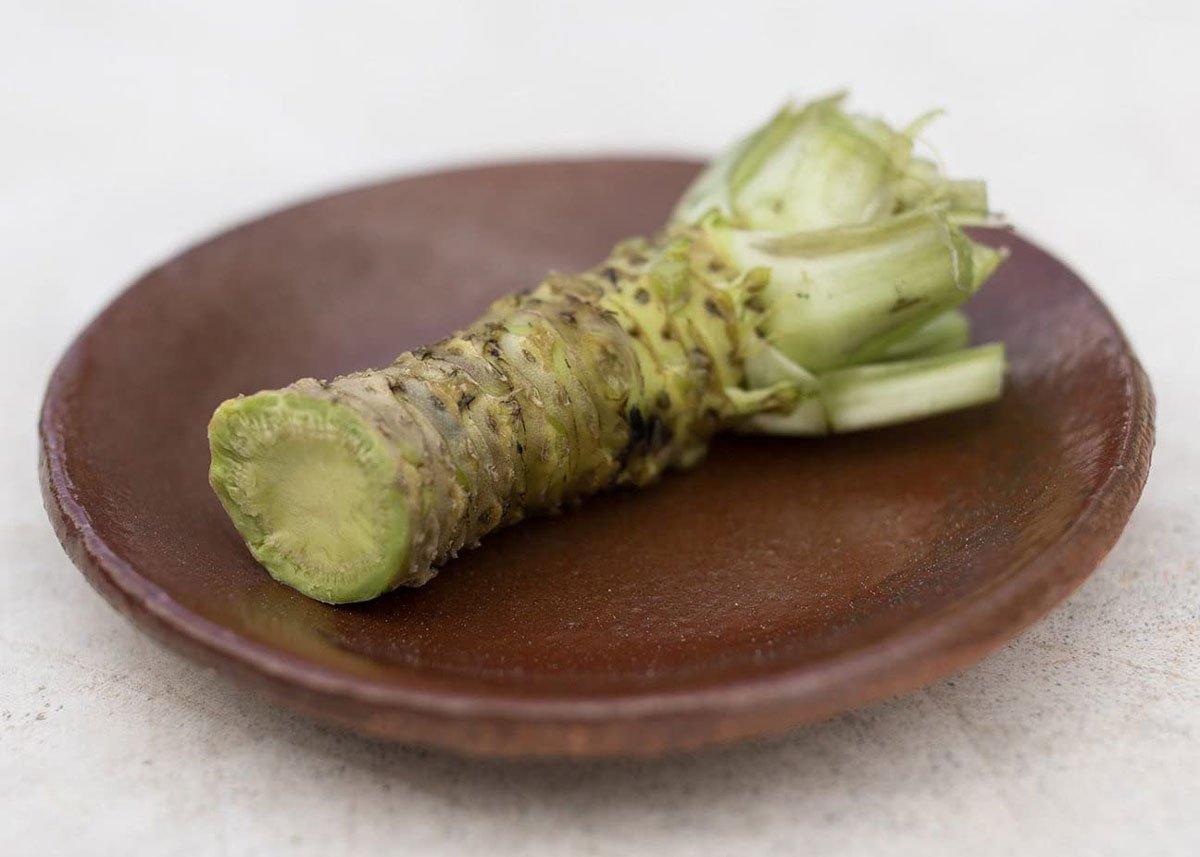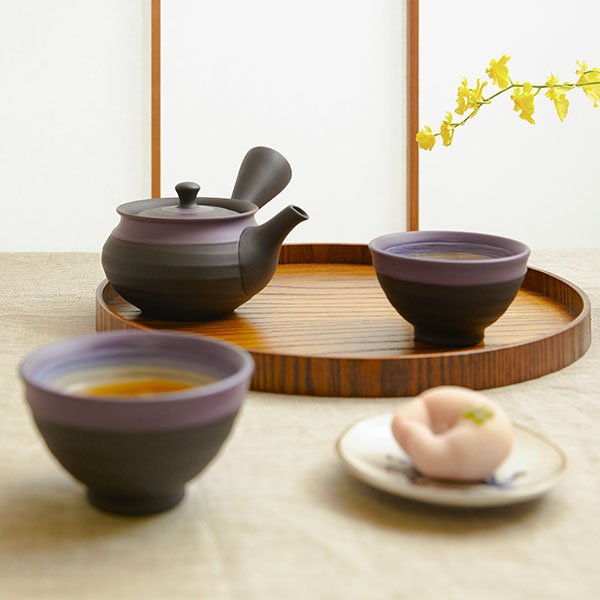What is Wasabi? The Most Common Questions Answered
by Casandra Lord | LIFESTYLE
Japanese Wasabi
Even if you’ve never had wasabi before, you probably know that it is green and spicy; but do you know the difference between real and fake wasabi? Do you know what a wasabi plant looks like? We’ll take a look at exactly what is Japanese wasabi, and find out how to seek out the good stuff!
1. What is Wasabi?
© Cassandra Lord, Mazuma Wasabi at Takijiri Wasabi
Wasabi is a plant that is a member of the mustard family, Brassicaceae, which also includes horseradish. Although it has some similarities in flavour to horseradish, the main difference between the two is that horseradish is a root vegetable, whereas wasabi is a rhizome. That means it is a plant stem that grows horizontally underground.
© Cassandra Lord, Wasabi at Takijiri Wasabi
When you buy wasabi in a store, it will be long, green, and bumpy, with a few stalks at the top. The part you grate and eat is the rhizome. On a wasabi farm though, all you will see are large, rounded leaves. These leaves can be eaten, and are great in a salad, but the flavour is nothing like as strong as the stem part.
2. Where does Japanese Wasabi Come From?
Wasabi Plant by Iwasaki Kanen, 1828
While there is some evidence that wasabi has been used medicinally for many centuries, it wasn’t until the Edo period (1603-1867) that cultivation began. The shogun Tokugawa Ieyasu took a liking to it, but kept cultivation methods under wraps. Eventually though, word started to spread, and in the early 1800s, wasabi had become widely used as seasoning for sushi, resulting in something of a sushi boom.
As wasabi became more popular, there was a need to find a way to process it for distribution, as refrigerators were not yet widespread. Taking inspiration from tea processing, powdered wasabi was born in the 1900s. Finally, tubed wasabi made its way onto the scene in the 1970s.
3. How is Wasabi Grown?
© Cassandra Lord, Wasabi at Takijiri Wasabi
Initially, wasabi might be planted by tissue culture, offshoots, or seeds. By using tissue culture, the plants will be identical to their mother plant, ensuring the same potential to produce a high quality, tasty plant. However, seeds are sometimes preferred to increase genetic variety and therefore resistance to disease.
Wasabi grows best in moist, shaded areas, and in nature might be found on the banks of mountain streams and springs, provided there is shade. For cultivation, they grow best in the shade where there is shallow and clear running water. Many of Japan’s wasabi farms are high up in the mountains, accessible by a route or monorail known only to the farmer.
4. When is the Wasabi Season?
© Cassandra Lord, Mazuma Wasabi at Takijiri Wasabi
Wasabi can be harvested and planted at any time throughout the year, but the best time is said to be at the turn of the season in the spring or fall. This is when growing conditions are optimal, because of the cool and moist weather that the wasabi plant prefers.
If you want the very spiciest wasabi, fall is the best time due to the colder weather. But some prefer the taste of hana wasabi or flower wasabi, which is the wasabi harvested just before the flowering in spring. It has a more bitter flavour and firmer texture.
5. What are the Different Types of Japanese Wasabi?
© MIURA, Yuji / Creative Commons, Grades of Wasabi
There are at least 18 different varieties of wasabi, but the main difference lies more in the way they grow, rather than any great variation in flavor.
The Fuji Daruma variety, for example, can reach a high grade within just one year, as opposed to the more common two-year wait. Whereas the Mazuma variety can take up to 36 months to be ready for harvest.
Some wasabi do have a more distinct flavour, such as the Mazuma variety, which is spicy but with a hint of sweetness, or the Misho variety, which is milder and a bit more moist. Broadly speaking, the flavour doesn’t change much, but the texture might. Some wasabi are wetter and softer, whereas others are firmer, resulting in a different texture when grated.
6. What is Fake Wasabi?
© Carlos Gracia / Creative Commons, Sushi with Wasabi
Not everything green wasabi paste is actually made from the wasabi plant. Fake wasabi, sold in tubes or sometimes as a powder, is usually made with a combination of horseradish, mustard, and green food colouring. This is called seiyo wasabi (西洋わさび) in Japanese, meaning western wasabi. Horseradish is considered better suited to the tube form as it tends to keep its tang for a long time after grating, making the taste much more pungent and spicy when compared to real wasabi. It is commonly used outside of Japan, as well as in lower-end sushi restaurants in Japan, as real wasabi requires more work to prepare.
© Antonio Rubio / Creative Commons, Fresh Wasabi
Real, freshly grated wasabi is not nearly as painful to eat plain as the fake stuff. It can be even be sweet and mild, to the point that it is often used in wasabi maki, a sushi roll with no filling other than fresh wasabi.
Real wasabi is called hon wasabi (本わさび), and is usually shipped from Japan frozen to maintain the flavour.
If you want to make sure you’re getting the real thing, just check the ingredients list to find out exactly what your wasabi is made of. If you’re looking at an ingredients list in Japanese, know that wasabi might be listed as わさび, ワサビ, or山葵!
7. How to Use Wasabi?
Japanese Wasabi
There are plenty of interesting ways to use fresh or hon wasabi. You might want to try a very small piece on its own before cooking with it to see how you like it before adding a lot to a dish, but some ideas for dishes are:
Wasabi maki (sushi rice rolled around a wasabi filling)
Steak with fresh wasabi and soy sauce
The classic sashimi or sushi with wasabi and soy sauce
Soba noodles with fresh wasabi
Wasabi goes well with beef as well as seafood, and some people even like it with chocolate desserts. But there are plenty of ways to use it, so don’t be afraid to experiment.
8. How to Prepare and Store Real Wasabi
© Beth Macdonald / Unsplash, Grating Wasabi
If you’ve got your hands on a fresh wasabi rhizome, to use it, simply trim off the bumps, then, holding the stalk end, grate from the bottom using a wasabi grater. If you don’t have a wasabi grater, you might want to check out the 30 Most Useful Japanese Kitchenware You Can Buy Online. Usually, wasabi is grated in a circular motion, but some use a straight back and forward move. Wasabi starts to lose its flavor quickly, so make sure to eat it within 15-20 minutes of grating.
Do not cook it directly, as it will lose flavor. If you want to make a sauce with it, first make and heat the sauce, then stir in the wasabi off the heat, just before eating.
To store the wasabi, cover it in damp paper towels in a bowl in the fridge. Replace the paper towels every few days. You might find that the outer layer starts to turn dark, but you can simply peel the layer off before use. It should store for a few weeks.
As for tube wasabi, this can simply be stored in the fridge.
There’s no shame in eating fake wasabi if that’s all that is available, but if you like wasabi with your dishes, you should try real wasabi at least once so you can appreciate the difference!
9. Where to Buy Wasabi?
If you’re looking to sample real wasabi abroad, it may be difficult to get your hands on an actual rhizome, so your best bet may be to buy Japanese wasabi online, like these ones on Amazon:
Hon Wasabi, available on Amazon
This wasabi paste is made of pure wasabi, from Shizuoka Prefecture, so you can imagine it growing in a shady glen in the foothills near Mount Fuji!
Kameya Wasabi, available on Amazon
Another pure wasabi paste from Shizuoka Prefecture, this time from the Izu Peninsula, famous for its rich volcanic soil.
Muso Wasabi, available on Amazon
Muso have been making wasabi products for nearly 7 decades, so you’re in good hands with this one.
Meisho Wasabi, available on Amazon
A popular brand of wasabi paste you’ll find in most supermarkets in Japan.
Fresh Wasabi, available on Amazon
If it’s the fresh wasabi root you’re after then, depending on stocks, you can also get this fresh rhizome grown in California.
JO SELECTS offers helpful suggestions, and genuine recommendations for high-quality, authentic Japanese art & design. We know how difficult it is to search for Japanese artists, artisans and designers on the vast internet, so we came up with this lifestyle guide to highlight the most inspiring Japanese artworks, designs and products for your everyday needs.
All product suggestions are independently selected and individually reviewed. We try our best to update information, but all prices and availability are subject to change. As an Amazon Associate, Japan Objects earns from qualifying purchases.


















TRAVEL | December 15, 2023